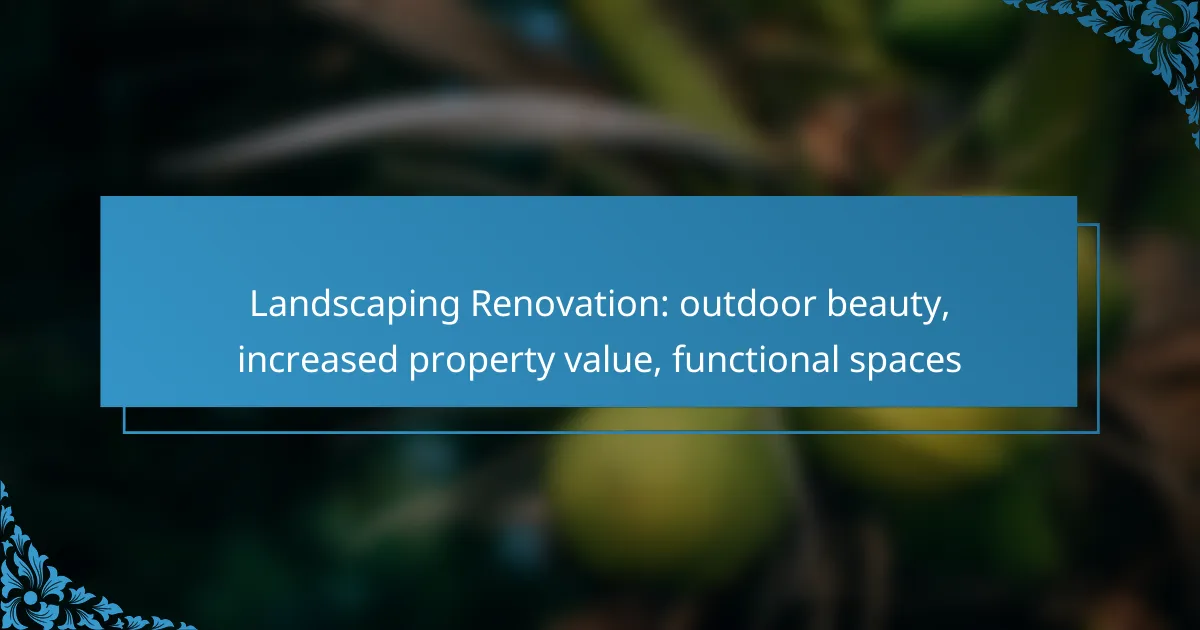Landscaping renovation is a powerful way to enhance outdoor beauty while increasing property value. By creating functional spaces that appeal to both homeowners and potential buyers, a well-executed landscaping project can transform any property into a stunning oasis. Incorporating elements like native plants and hardscaping not only elevates aesthetics but also promotes sustainability and usability.

How can landscaping renovation enhance property value in Toronto?
Landscaping renovation can significantly boost property value in Toronto by improving aesthetics, functionality, and market appeal. A well-designed outdoor space not only attracts potential buyers but also enhances the overall living experience for homeowners.
Increased curb appeal
Enhancing curb appeal is one of the most immediate benefits of landscaping renovation. A visually appealing exterior can make a strong first impression, encouraging potential buyers to explore the property further. Simple upgrades like fresh plantings, well-maintained lawns, and attractive walkways can elevate the overall look of a home.
In Toronto, where real estate competition is high, investing in landscaping can differentiate a property from others on the market. Features such as decorative fences, outdoor lighting, and seasonal flowers can create a welcoming atmosphere that draws attention.
Higher market demand
Properties with well-designed outdoor spaces often see higher market demand. Buyers are increasingly looking for homes that offer functional outdoor areas for relaxation and entertainment. Renovated landscapes can highlight these features, making the property more appealing.
In Toronto, homes with outdoor kitchens, patios, or gardens can command a premium price. Buyers are willing to pay more for properties that provide additional living space outside, reflecting a growing trend toward outdoor lifestyles.
Improved outdoor functionality
Landscaping renovation can enhance outdoor functionality by creating usable spaces tailored to homeowners’ needs. This can include installing decks, patios, or play areas that cater to family activities and gatherings. Thoughtful design can transform a yard into a multi-functional space.
When planning a renovation, consider factors like sun exposure, privacy, and accessibility. In Toronto’s climate, incorporating elements such as native plants or drought-resistant landscaping can also reduce maintenance costs and improve sustainability, adding further value to the property.

What are the key steps in a landscaping renovation project?
A landscaping renovation project typically involves several key steps, including consultation, design planning, and implementation. Each phase is crucial for transforming outdoor spaces into beautiful, functional areas that can enhance property value.
Initial consultation with a local landscaper
The first step in a landscaping renovation is to schedule an initial consultation with a local landscaper. During this meeting, you will discuss your vision, budget, and any specific requirements for your outdoor space.
It’s beneficial to prepare a list of your goals, such as creating a garden, installing a patio, or improving drainage. This will help the landscaper understand your needs and provide tailored recommendations.
Design planning and approval
After the consultation, the landscaper will create a design plan that outlines the proposed changes. This plan may include sketches, plant selections, and materials to be used.
Review the design carefully and ensure it aligns with your vision and budget. It’s common to make adjustments at this stage, so communicate openly with your landscaper to finalize the plan before moving forward.
Implementation of landscaping features
Once the design is approved, the implementation phase begins. This involves the actual construction and installation of landscaping features such as pathways, gardens, and outdoor structures.
During this phase, it’s important to monitor the progress and ensure that the work adheres to the agreed-upon design. Regular communication with the landscaper will help address any issues that arise and keep the project on track.

What landscaping features should be included for optimal results?
To achieve optimal results in landscaping, focus on incorporating features that enhance beauty, functionality, and sustainability. Key elements include native plants, hardscaping components, and water features, each contributing to a cohesive outdoor space.
Native plants for sustainability
Using native plants is essential for creating a sustainable landscape. These plants are adapted to the local climate and soil conditions, requiring less water and maintenance compared to non-native species. They also support local wildlife, enhancing biodiversity.
When selecting native plants, consider a mix of perennials and shrubs that bloom at different times throughout the year. This not only provides continuous color but also attracts pollinators like bees and butterflies. Aim for a diverse planting scheme to create a resilient ecosystem.
Hardscaping elements like patios
Hardscaping features, such as patios and walkways, add structure and functionality to your outdoor space. They provide areas for relaxation and entertainment, making your landscape more usable. Materials like stone, brick, or pavers can be chosen based on durability and aesthetic appeal.
When designing hardscaping, ensure it complements the natural elements of your garden. Consider incorporating seating walls or fire pits to enhance the space’s usability. Proper drainage is crucial to prevent water pooling, so plan your layout accordingly.
Water features for aesthetics
Water features, such as ponds, fountains, or waterfalls, significantly enhance the visual appeal of a landscape. They create a tranquil atmosphere and can serve as a focal point in your garden. Additionally, the sound of flowing water can mask unwanted noise, adding to the serenity of the space.
When planning a water feature, consider its size and placement to ensure it fits harmoniously within your landscape. Small features may require less maintenance, while larger installations can attract wildlife. Always check local regulations regarding water use and installation to ensure compliance.

What permits are required for landscaping renovation in Ontario?
In Ontario, landscaping renovation may require various permits depending on the scope of the project. Homeowners should check local regulations to ensure compliance with building codes and environmental standards.
Building permits for structures
When adding structures such as decks, fences, or pergolas, a building permit is often necessary. This ensures that the construction meets safety standards and zoning regulations. Homeowners should consult their local municipality to determine specific requirements and fees, which can vary widely.
Typically, the application process involves submitting plans that detail the proposed structure, including dimensions and materials. It’s advisable to allow several weeks for permit approval, especially during peak seasons.
Environmental assessments for water features
If your landscaping renovation includes installing water features like ponds or fountains, an environmental assessment may be required. This assessment evaluates the potential impact on local ecosystems and water quality. In Ontario, regulations may mandate that these assessments are conducted by qualified professionals.
Before proceeding, check with the local conservation authority to understand the specific requirements and any necessary permits. Engaging with local experts can help streamline the process and ensure compliance with environmental laws.

How long does a landscaping renovation typically take?
A landscaping renovation usually takes anywhere from one to eight weeks, depending on the project’s size and complexity. Smaller projects can be completed quickly, while larger renovations require more time for planning and execution.
Small projects: 1-2 weeks
Small landscaping projects, such as planting new flower beds or installing a simple patio, typically take about one to two weeks. These projects often involve minimal disruption and can be completed with a small crew.
To ensure a smooth process, prepare the site in advance by clearing debris and marking the layout. This can help the project stay on schedule.
Medium projects: 2-4 weeks
Medium-sized renovations, like adding a deck or creating a garden pathway, generally require two to four weeks. These projects may involve more detailed planning and coordination with contractors.
Consider the weather and seasonal factors, as they can impact the timeline. It’s advisable to schedule work during favorable conditions to avoid delays.
Large projects: 4-8 weeks
Large landscaping renovations, such as complete yard overhauls or extensive hardscaping, can take four to eight weeks or longer. These projects often involve multiple phases, including design, excavation, and installation.
Engaging a landscape architect can help streamline the process and ensure compliance with local regulations. Be prepared for potential delays due to permitting or weather-related issues.

What are the average costs for landscaping renovation in Canada?
The average costs for landscaping renovation in Canada typically range from a few thousand to several thousand Canadian dollars, depending on the scope and complexity of the project. Homeowners should consider factors like materials, labor, and design when budgeting for these renovations.
Basic renovations: $2,000 – $5,000
Basic landscaping renovations often include tasks such as lawn installation, planting shrubs, and adding mulch or decorative stones. These projects can significantly enhance the visual appeal of a property without requiring a large investment.
When planning for basic renovations, consider the size of your yard and the specific features you want to include. For example, a simple flower bed or a small tree can be added within this budget, while larger projects may require more funds.
To maximize your investment, focus on low-maintenance plants and materials that are suited to your local climate. This approach not only saves money but also ensures that your landscaping remains attractive over time with minimal upkeep.
